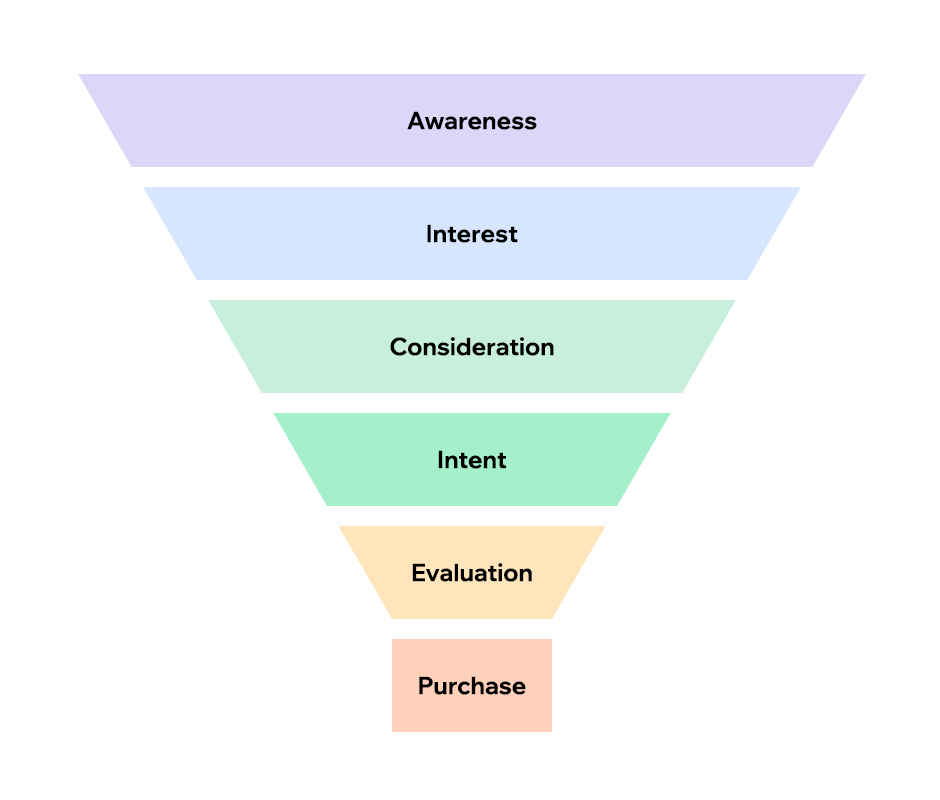Every website is unique and different in its own way, so what actions do you want customers to take on your website? Depending on your business the answer to this question may vary from purchasing a product, getting more information, subscribing to a blog or newsletter, or donating money to your cause. When a customer completes the action you are wanting them to take it’s called a conversion. You can encourage conversions by refining your marketing funnel. In this blog post I’m going to explain what a marketing funnel is, how to identify yours, and the steps you can take to improve your funnel for increased results.
What Is A Marketing Funnel?
Marketing funnels represent the steps a potential customer will take on their journey to becoming a paying customer. Funnels are broken down into different sections, each designed to represent a pivotal moment someone can have with your business. Funnels are a way of understanding your customer’s experience. It starts the second someone learns about your business and it continues through the moment that they become a customer. Successful funnels encourage customer advocacy, loyalty, and repeat business. A healthy funnel looks like this:

As you make your way down the funnel there are fewer people at each step. Not every single person who visits your website will become a customer, right? Optimizing your funnel increases the number of people who make it all the way through. In order to refine your customer’s experience and your funnel, you need to understand what happens at each step.
Marketing Funnel Breakdown
Remember, each section of the funnel represents a pivotal moment in your customer’s journey.
Marketing Efforts/SEO – Your marketing and search engine optimization (SEO) efforts aren’t technically part of the funnel, but they do influence the user experience and willingness to move through it. Think of your marketing efforts as food for your funnel. Without any marketing or SEO efforts, prospective customers won’t know you exist and can’t find their way to your website. Your marketing efforts will directly affect awareness of your business or website.
Awareness – This lives at the top of the funnel and goes hand-in-hand with your marketing efforts. At this stage, people are finding your website and discovering what it is you offer. They’re learning more about your website or retail store.
Interest – Once someone is aware you exist, one of two things will happen: you’ll grab their interest or they’ll leave your site having decided that their needs can’t be met by your offerings. To increase the number of interested parties, make sure your site has clear CTAs (Call-to-Actions) and a smooth user experience. If you’ve explained and positioned your offerings clearly people will likely take greater interest in your services and move further down the funnel.
Evaluation – The potential customer is aware and interested. Now they are seriously considering your product. Many things can happen in the evaluation step: prospective customers are trialing your goods or services, or perhaps they’re taking advantage of your free initial consultations. People at the evaluation stage are on the cusp of becoming paying customers.
Conversion – This is the moment you’ve been working so hard for. Conversions happen when site visitors complete the action(s) you want them to take. Conversions can include purchasing an item, signing up for your something, making a donation..etc. When someone converts, you earn a customer or client.
Loyalty and Advocacy – Some funnels may put these two portions into separate parts. But in my eyes, they go hand-in-hand. Treating customers well and providing good experiences for them will earn you their loyalty and a loyal customer is a repeat customer. These customers are also more likely to recommend your product or service to people they know. Customer advocacy and recommendations can make a world of difference. In fact, one study found 50% of Americans would choose word of mouth if they had to pick one source of information.
Keep in mind, repeat customers go through the funnel every time they make a purchase from you. So, don’t get lax with your website experience or product offerings because you want them to make it all the way through the funnel each time they visit.
What Does Your Funnel Look Like?
Now that you know what a funnel looks like, put yourself in a potential customer’s shoes to explore your funnel. Ask yourself these questions:
Where can they find out about my business? – Do you have enough of a digital presence for people to know you actually exist? Take stock of your social media profiles, marketing materials and efforts to identify and address any opportunities you might be missing out on.
Is my content interesting? – Pumping out content for the sake of having content isn’t a great strategy. Make sure your content speaks to your desired audience. Who do you want as a customer? What are their needs?
What’s my checkout process like? – If your checkout process is clunky then you’re in trouble. You want your visitors to move seamlessly from evaluation to conversion.
Do What’s Best For Your Business
Reviewing and making optimization changes to your funnel should increase website traffic, visitor interest, and conversions. Use the marketing funnel description I provided above to understand the different steps along your customer’s journey. Once you understand what that journey looks like, pretend you’re a potential customer to evaluate your specific funnel. It wouldn’t hurt to ask a friend or person you trust for their feedback as well!
